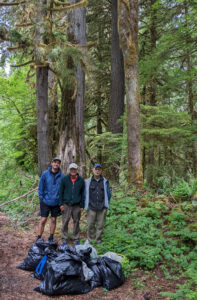Working to eradicate an established invasive species can leave land managers and conservationists feeling a bit like Sisyphus, but new approaches may help turn the tide in their favor.
In June, Cascade Forest Conservancy led three separate groups of volunteers to help contend with an invasive plant species that is increasingly concerning local botany specialists and conservationists. They employed a combination of high-tech tools, a new experimental approach, and good old-fashioned elbow grease to help protect old-growth habitats!
MEET STINKY BOB: A SMALL PLANT AND A BIG PROBLEM FOR OLD-GROWTH HABITATS
The plant, Geranium robertianum, commonly known as herb-Robert, stinky Bob, and many other names including red robin, fox geranium, crow’s foot, and death come quickly, is an attractive plant with pink flowers and unique lobed leaves–a welcome and fairly common sight in its native range throughout Europe, Asia, and Northern Africa. But here in Washington, where it has been recognized as a noxious species in the 1990s, herb-Robert is a problem.
Many populations of non-native plants seem to be concentrated in heavily disturbed areas such as roadsides, within clear-cuts, or around the edges of parking lots. Others, like herb-Robert, are different and may be capable of overwhelming and replacing healthy and diverse native plant communities.

Herb-Robert is particularly concerning. The shade-tolerant weed has been found in native-rich old-growth forests that are typically resistant to infestation by invasive species. Locally, it has been found in old-growth habitats along the Lewis River corridor and other remote areas of the forest. We have seen that if left unchecked, herb-Robert can take over a landscape, drastically reducing local biodiversity and out-competing native species that offer important benefits to pollinators, wildlife, and the ecosystem as a whole.
ELBOW GREASE, GRIT, AND GPS
With the help of hard-working and generous volunteers, CFC has been collaborating with the Forest Service to map and manage herb-Robert in old-growth forests near the Lewis River and along a road near the Cedar Flats Research Natural Area (RNA) to maintain a weed-free buffer that has so far prevented the weed’s spread into the RNA. In June, eleven volunteers braved the drizzly weather to once again help protect the health of these places.
We stayed fairly dry under the dense overstory as we revisited plots where we have been pulling herb-Robert for four seasons. Once again, volunteers got right to work hand-pulling the pesky invaders. The plants were securely loaded into large garbage bags until they were so full we could barely carry them on our three-mile hike back to our cars.

Staff and volunteers also carried iPads loaded with GPS-linked data collection apps and spatially-linked photos to track the project’s progress year to year and identify the exact location of each patch. We found fewer and smaller plants than in previous years–indicating that previous hands-pulling efforts have had a positive impact in the area. We hope that our continued efforts are helping to deplete the herb-Robert seed bank by removing the plants before their seeds can ripen and disperse (seeds can be ejected 15-20 feet).
We also found a previously unmapped plot that was larger than our volunteers could tackle on this trip. Fortunately, our volunteers still helped combat the invasive plant by mapping and sharing the location with partners at the Forest Service and the Skamania County Noxious Weed Control Program, who have more resources to manage sites that require long-term treatment.
We had extra help this year from an additional group of volunteers who joined us thanks to a partnership with the Multnomah Whiskey Library. With their help, we cleared even more plants from areas near Cedar Flats and a few additional plots near the parking lot of the popular Ape Caves. Removing the plants from this high-traffic area is helping prevent seeds from being carried to new locations on visitors’ boots, gear, bike tires, or even pets!
SNIFFING OUT STINKY BOB
A third group spent a weekend kicking off a brand-new way for volunteers (and their four-legged friends) to make a difference in efforts to combat invasive weeds. We were working with Rogue Detection Teams (RDT), an amazing organization that trains rescue dogs to find everything from rare species of caterpillars to wide-ranging predators in remote areas using their incredible sense of smell, to test a new approach to managing invasive species.

Under the expert guidance of the RDT bounders, our human and dog volunteer teams began the process of learning to sniff out herb-Robert. Specially trained canines have been used in conservation work for years, but this new program is the first to explore whether or not the pets of science and restoration volunteers can be trained to successfully find and point out hard-to-find weeds in dense understories. Needless to say, everyone had a blast!

Stay tuned for our upcoming blog exploring this exciting new partnership.


